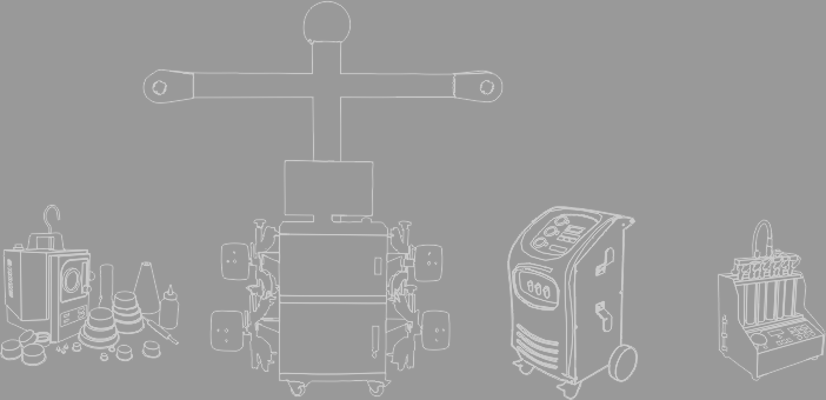A brief knowledge will be necessary to have a rough idea about wether a wheel is out of the specifications it outer to be. by both eye check tire wear and road test. In that wheel alignment machine is only a reference tool, it tells you WHAT, but not HOW or WHY.
Eye check tyre worn
Its necessary to check the status of the wheels, say, tirewear. Factor like tire pressure, lose knob, bend pole etc, might be the reason of improper wheel position specification, but tirewear is the result.
The way your tires wear is a good indicator of the healthy status of the wheel related component of your car. Abnormal wear patterns are often caused by lacking of simple tire maintenance, or wheel alignment. Tires should be inspected at a relative high frequency; at least once a month. Learning to read the tirewear is really important for the wheel alignment operator, or the car owner himself, because improper tirewear gonna cost you little money if you can find it out and fix it early, or you have to spend a lot of money changing the bearing or other components of the suspension system when its too late. it will be a good idea to have a thread measurement tool, and a small tire pressure gauge in your pocket.
Different kind of tyre worn pattern reflect different reasons:
Over Inflation
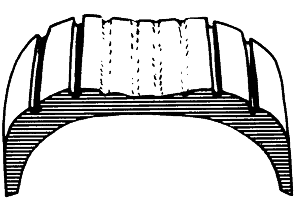
Excessive wear at the center of the tread indicates that the air pressure in the tire is consistently too high. The tire is riding on the center of the tread and wearing it prematurely. Many times, the "eyeball" method of inflation (pumping the tires up until there is no bulge at the bottom) is at fault; tire inflation pressure should always be checked with a reliable tire gauge. Occasionally, this wear pattern can result from outrageously wide tires on narrow rims. The cure for this is to replace either the tires or the wheels.
Under Inflation

This type of wear usually results from consistent under inflation. When a tire is under inflated, there is too much contact with the road by the outer treads, which wear prematurely. Tire pressure should be checked with a reliable pressure gauge. When this type of wear occurs, and the tire pressure is known to be consistently correct, a bent or worn steering component or the need for wheel alignment could be indicated. Bent steering or idler arms cause incorrect toe-in and abnormal handling characteristics on turns.
Feathering
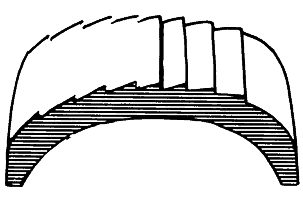
Feathering is a condition when the edge of each tread rib develops a slightly rounded edge on one side and a sharp edge on the other. By running your hand over the tire, you can usually feel the sharper edges before you'll be able to see them. The most common cause of feathering is incorrect toe-in setting, which can be cured by having It set correctly. Occasionally toe-in will be set correctly and this wear pattern still occurs. This is usually due to deteriorated bushings in the front suspension, causing the wheel alignment to shift as the car moves down the road.
One Side Wear
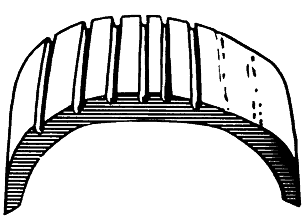
When an inner or outer rib wears faster than than the rest of the tire, the need for wheel alignment is indicated. There is excessive camber in the front suspension, causing the wheel to lean too much to the inside or outside and putting too much load on one side of the tire. The car may simply need the wheels aligned, but misalignment could be due to sagging springs, worn ball joints, or worn control arm bushings. Because load has a great affect on alignment, be sure the car is loaded the way it's normally driven when you have the wheels aligned; this is particularly important with independent rear suspension cars.
Cupping
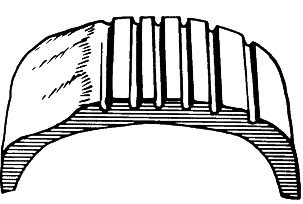
Cups or scalloped dips appearing around the edge of the tread on one side or the other, almost always indicate worn (sometimes bent) suspension parts. Adjustment of wheel alignment alone will seldom cure the problem. Any worn component that connects the wheel to the car (ball joint, wheel bearing, shock absorber, springs, bushings, etc.) can cause this condition. Worn components should be replaced with new ones. The worn tire should be balanced and possibly moved to a different location on the car. Occasionally, wheels that are out of balance will wear like this, but wheel imbalance usually shows up as bald spots between the outside edges and center of the tread.
Second-rib Wear
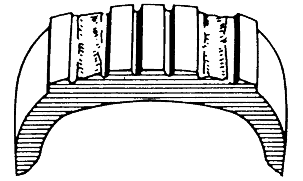
Second-rib wear is normally found only in radial tires, and appears where the steel belts end in relation to the tread. Normally, it can be kept to a minimum by paying careful attention to tire pressure and frequently rotating the tires. Some car and tire manufacturers consider a slight amount of wear at the second rib of a radial tire normal, but that excessive amounts of wear indicate that the tires are too wide for the wheels. Be careful when having oversize tires installed on narrow wheels.
Road test
A road test is a must for determine the alignment healthy status of a vehicle, method:
Choose a straight and flat road with less traffic
The status of wheels reflects won't be effective at low speed, shall choose a traight road with good condition, and can be too much traffic. in that you will have to drive the car up to about 80km/h.
Hands off the steering wheel
when the speed reach 60km/hr to 80 km/hr, keep the car run straight, hands off the steering wheel, to see if the vehicle turn to the left or turn to the right.
Road test shall be carried out before and after wheel alignment.
